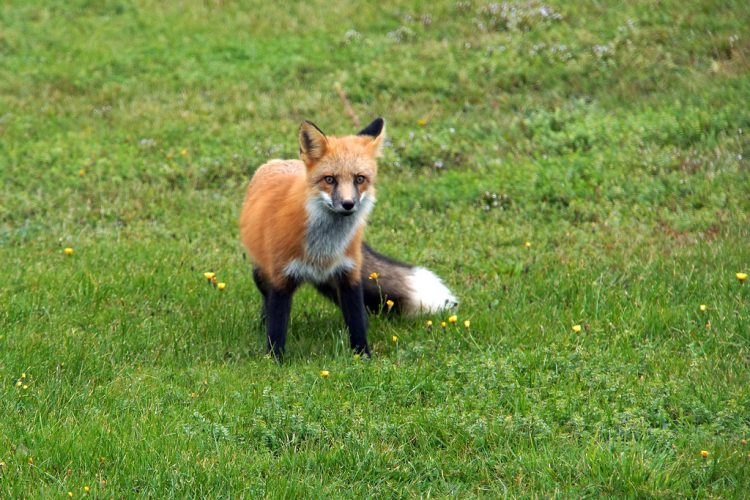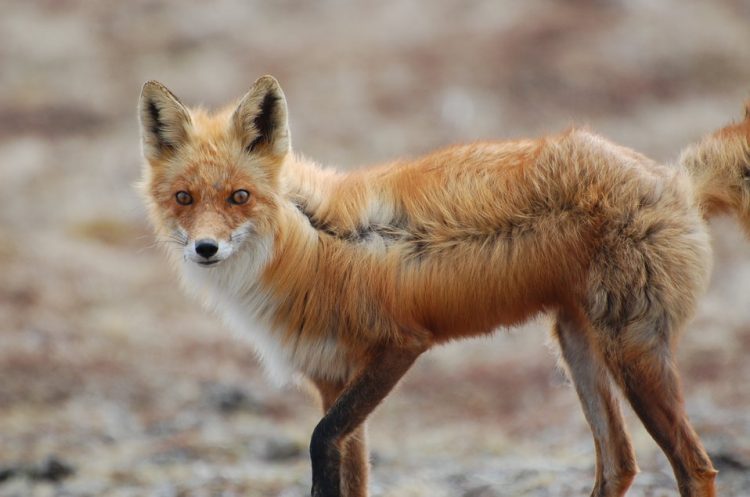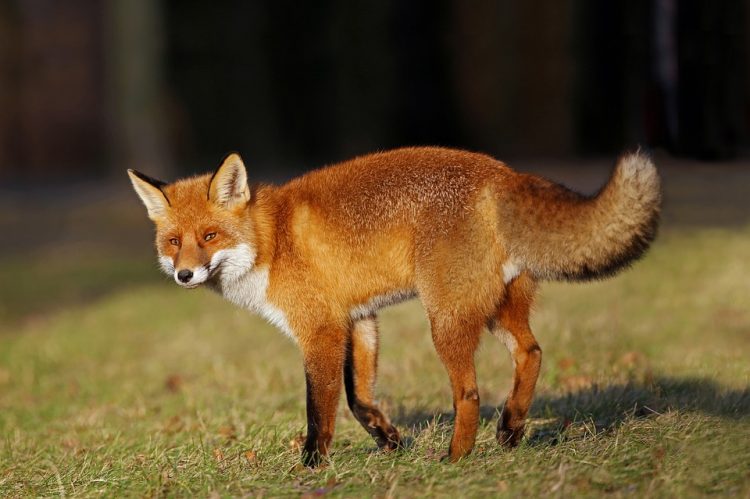Page Contents
Red Fox Facts
Unlike the more social wolves, foxes and coyotes tend to hunt alone, although coyotes may hunt larger prey in pairs. Foxes and coyotes are primarily carnivorous, preying predominantly on small mammals.
But they also may eat insects, fruits, berries, seeds, and nuts. Foxes are found throughout most of the United States and Canada, including the arctic, as are coyotes except for the southeastern United States. Foxes and coyotes are active mainly at night.
Red Fox (Vulpes vulpes) are present throughout the United States and Canada except in the southeast, extreme southwest, and parts of the central states. Red fox preys extensively on mice and voles but also feeds on other small mammals, insects, hares, game birds, poultry, and occasionally seeds, berries, and fruits.
Twelve subspecies are recognized in North America. The dog-sized red fox has a body of about 56 to 63 cm in length, with a 35 to 41 cm tail. They weigh from 3 to 7 kg, with the males usually outweighing the females by about 1 kg.
Red Fox Habitat
As the most widely distributed carnivore in the world, the red fox can live in habitats ranging from arctic areas to temperate deserts. Red foxes utilize many types of habitat cropland, rolling farmland, brush, pastures, hardwood stands, and coniferous forests.
They prefer areas with broken and diverse upland habitats such as occur in most agricultural areas. They are rare or absent from continuous stands of pine forests in the southeast, moist conifer forests along the Pacific coast, and semiarid grasslands and deserts.
Red Fox Food Habits
The red fox feeds on both animal and plant material, mostly small mammals, birds, insects, and fruit. Meadow voles are a major food in most areas of North America. However, other common prey includes mice and rabbits. Game birds (e.g., ring-necked pheasant and ruffed grouse) and waterfowl are seasonally important prey in some areas.
Plant material is most common in red fox diets in summer and fall when fruits, berries, and nuts become available. Red foxes often cache food in a hole for future use. They also are noted as scavengers on carcasses or other refuse.
Most activity is nocturnal and at twilight. In winter, foxes do not undergo hibernation or torpor; instead, they are active year-round. They undergo one molt per year, which usually begins in April and is finished by June. The winter coat is regrown by October or November in northern latitudes.
Breeding occurs earlier in the south than in the red fox’s northern ranges. A mated pair maintains a territory throughout the year, with the male contributing more to its defense than the female. Pups are born and reared in an underground den, and the male assists the female in rearing the young, bringing food to the den for the pups.
Pups first emerge from the den when 4 to 5 weeks old. Once considered solitary, red foxes now are reported to exhibit more complex social habits. A fox family, the basic social unit, generally consists of a mated pair of one male and several related females. The additional females are usually nonbreeders that often help the breeding female.
Range
The home ranges of individuals from the same family overlap considerably, constituting a family territory. Territories of neighboring red fox families are largely non-overlapping and contiguous, usually resulting in all parts of a landscape being occupied by foxes. Territory sizes range from less than 50 to over 3,000 ha. Territories in urban areas tend to be smaller than those in rural areas.
Adults visit most parts of their territory on a regular basis; however, they tend to concentrate their activities near their dens, preferred hunting areas, abundant food supplies, and resting areas. Territory boundaries often conform to physical landscape features such as well-traveled roads and streams.
Territory defense is primarily by nonaggressive mechanisms involving urine scent-marking and avoidance behaviors. Scent marking occurs throughout the territory; there is little patrolling of territory boundaries. Each fox or family usually has a main underground den and one or more other burrows within the home range.
Most dens are abandoned burrows of other species e.g., woodchucks, and badgers. Tunnels are up to 10 m in length and lead to a chamber 1 to 3 m below the surface. Pup-rearing dens are the focal point of fox activity during spring and early summer. Foxes have some rest sites and usually forage away from the den.
One red fox family per 100 to 1,000 ha is typical. Red foxes have larger home ranges where population densities are low and in poorer habitats. Most young foxes, especially males, disperse before the age of 1, usually from September to March, with peaks in dispersal in October and November.
Foxes usually produce pups in their first year, except in extremely high-density areas and in some years in northern portions of their range where they may delay breeding until the next season. Litter size generally averages four to six pups. The pups leave the den about 1 month after birth, and they are weaned by about 8 to 10 weeks of age.
Red foxes incur high mortality rates as a result of the shooting, trapping, disease, and accidents at roadkill. Two factors that tend to limit red fox abundance are competition with other canids, especially coyotes, and seasonal limits on food availability. Fecundity is higher in areas of high mortality and low population densities.
Similar Species
The arctic fox (Alopexlagopus) is smaller than the red fox (body length approximately 51 cm; weight 3.2 to 6.7 kg) and is restricted in its distribution to the arctic, found in the United States only in Alaska. This species primarily scavenges for food but also eats lemmings, hares, birds, and eggs as well as berries in season.
The swift fox (Vulpes velox) is smaller than the red fox (body length 38 to 51 cm; weight 1.8 to 2.7 kg) and inhabits the deserts and plains of the southwest and the central United States. It densifies in ground burrows and feeds on small mammals and insects.
The kit fox (Vulpes macrotis) is similar in size to the swift fox and is considered by some to be the same species, although it has noticeably larger ears. It inhabits the southwestern United States and prefers open, level, sandy areas, and low desert vegetation. It feeds on small mammals and insects.
The gray fox (Urocyon cinereoargenteus) is similar in size (body length 53 to 74 cm; weight 3.2 to 5.8 kg) to the red fox and ranges over most of the United States except the northwest and northern prairies. It is inhabiting chaparral, open forests, and rimrock regions. Secretive and nocturnal, gray foxes will climb trees to evade enemies. They feed primarily on small mammals but also eat insects, fruits, acorns, birds, and eggs.
The coyote (Canis latrans) is much larger (body length 81 to 94 cm; weight 9 to 22 kg) than the red fox and is found throughout most of the United States (except possibly eastern), western Canada, and Alaska.
It inhabits prairies, open woodlands, brushy and boulder-strewn areas, and dens in the ground. Coyotes share some feeding habits with the red fox but also scavenge and hunt larger prey in pairs.







Read More – The Snapping Turtles (Chelydra serpentina)
Affiliates Links:
- How One Woman Discovered the Female Fat-Loss Code Missed by Modern Medicine And Lost 84lbs Using a Simple 2-Step Ritual That 100% Guarantees Shocking Daily Weight Loss
- 60 Seconds Habit ! That Reversed Type 2 Diabetes and Melted 56 lbs of Fat
- Boost Your Energy, Immune System, Sexual Function, Strength & Athletic Performance
- Diabetes Remedy # 1 Mega Offer for 2019





